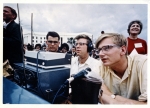On March 13th, NPR featured a story on the Project South Collection held in the University Archives and Archive of Recorded Sound. Entitled "A King Speech You've Never Heard--Plus, Your Chance to Do Archive Sleuthing," the article describes the rich treasures found within the audio recordings, including a speech by Martin Luther King, Jr., and asks for volunteers to comb through the materials and share their findings. It also asks for volunteers to help us transcribe the remainder of the collection. So far, our crowd-sourcing experiment has yielded over twenty volunteers, who have completed five transcripts. Several more transcripts are in the works. We thank NPR and all our volunteers for their efforts as there is much work that remains to be done for this amazing collection.
The Project South Collection consists of transcribed interviews with Civil Rights workers in the South recorded by several Stanford students affiliated with the campus radio station KZSU during the summer of 1965. The project was sponsored by the Institute of American History at Stanford. Includes information relating to black history; interviews of members of the Congress of Racial Equality, the Mississippi Freedom Democratic Party, the NAACP, the Southern Christian Leadership Conference, and the Student Non-violent Coordinating Committee; recordings of formal and informal remarks of persons working with smaller, independent civil rights projects, of local blacks associated with the civil rights movement, and other people, including Ku Klux Klansmen; "action tapes" of civil rights workers canvassing voters, conducting freedom schools, or participating in demonstrations ; speeches by and/or interviews with Ralph David Abernathy, Charles Evers, James Farmer, Martin Luther King, Jr., and Hosea Williams; and a Ku Klux Klan meeting and speech made by Robert Sheldon, its Imperial Wizard.









 Stanford University Home
Stanford University Home